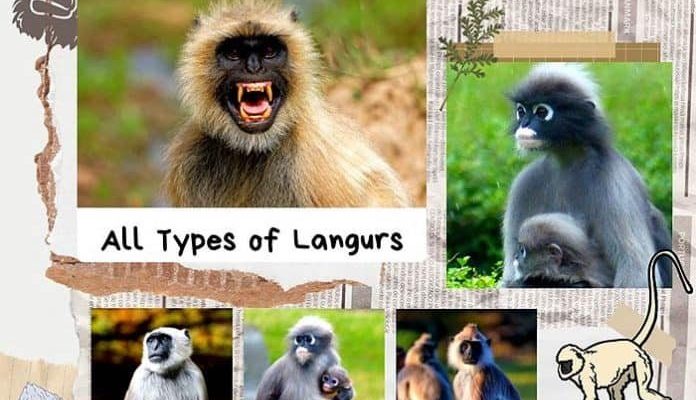
In this article, we’ll explore ten animals that resemble langurs and give you some handy tips on how to tell them apart. Whether you’re a budding wildlife enthusiast or just curious about the natural world, you’ll find some fascinating similarities and differences that make each species special in its own right. So, grab a cup of coffee, and let’s dive into the wild world of primates and their distant relatives!
1. Black Crested Gibbon
The black crested gibbon, often found in the forests of Southeast Asia, is known for its acrobatic skills and haunting calls. Much like langurs, these gibbons are incredibly agile, making them masters of the treetops. They have long arms and slender bodies that help them swing from branch to branch with ease.
How to Tell Them Apart: One major difference is their coloration. While langurs can vary in color depending on the species, black crested gibbons are primarily black with a distinctive white crown. Their vocalizations are also unique; you might hear them making loud, complex calls that echo through the forest, while langurs typically have softer, more social sounds.
Key Features of Black Crested Gibbons:
- Color: Black with a white crown
- Habitat: Rainforests of Southeast Asia
- Social Structure: Live in family groups
2. Dusky Leaf Monkey
Dusky leaf monkeys, or spectacled langurs, are another cousin to the langur. Found primarily on the Malay Peninsula, they have a similar appearance, characterized by a mix of gray and brown fur. One of their standout features is the white markings around their eyes, giving them a “spectacled” look.
How to Tell Them Apart: While both dusky leaf monkeys and langurs have long tails and slender builds, the eye markings are a clear giveaway. Langurs tend to have uniform coloration without such distinctive facial features. Additionally, dusky leaf monkeys are known for their playful nature, often seen frolicking and playing in the trees.
Key Features of Dusky Leaf Monkeys:
- Color: Grayish-brown with white eye patches
- Habitat: Tropical forests in Malaysia and Thailand
- Behavior: Playful and social
3. Proboscis Monkey
Proboscis monkeys are hard to miss, thanks to their large noses that protrude prominently from their faces. They inhabit the mangrove forests of Borneo and Sumatra, where they spend much of their time in trees, much like langurs. Their unique features and sociable behavior make them equally fascinating.
How to Tell Them Apart: The most obvious difference is that long, floppy nose! While langurs have more refined facial structures, the proboscis monkey boasts a nose that can be quite a sight. They also have a reddish-brown coat, making them stand out in their lush green surroundings.
Key Features of Proboscis Monkeys:
- Color: Reddish-brown with a distinctive large nose
- Habitat: Mangrove forests of Borneo and Sumatra
- Unique Behavior: They prefer to live near water
4. Marmoset
Marmosets are tiny primates with an energetic personality. These little guys can be found in the forests of South America and are known for their sociability and strong family bonds. Despite their smaller size compared to langurs, they share a similar lifestyle, often living in groups.
How to Tell Them Apart: Size is the first thing you’ll notice—marmosets are significantly smaller than langurs. Additionally, their fur is much fluffier and often has a lighter coloration. While langurs are known for their agility in trees, marmosets tend to be a bit more playful and curious, often exploring their environments for food.
Key Features of Marmosets:
- Color: Varies from brown to black with fluffy fur
- Habitat: South American rainforests
- Behavior: Highly social and inquisitive
5. Macaque
Macaques are a diverse group of primates found across Asia, known for their adaptability to various environments. They have a similar body structure to langurs and are often seen in social groups. However, unlike langurs, macaques have a more varied diet, including fruits, seeds, and even human leftovers.
How to Tell Them Apart: Macaques usually exhibit a more robust body and different facial features, such as a less elongated snout. Their fur can vary dramatically between species, and their behaviors include more ground foraging compared to the tree-dwelling langurs.
Key Features of Macaques:
- Color: Varies widely, often brown or gray
- Habitat: Found in Asia, often near human settlements
- Diet: Omnivorous, flexible diet including human food
6. Tarsier
Tarsiers are small primates that are more closely related to lemurs than to langurs, but their large eyes and agile movements can remind you of langurs. They are primarily nocturnal and use their incredible vision to hunt insects and small animals.
How to Tell Them Apart: Tarsiers have enormous round eyes, which are a stark contrast to the smaller, more human-like eyes of langurs. They’re also tiny, with body sizes often less than a cat. Their nocturnal habits set them apart, as langurs are generally diurnal and social.
Key Features of Tarsiers:
- Color: Usually gray or brown with large eyes
- Habitat: Rainforests in Southeast Asia
- Behavior: Nocturnal hunters, solitary or in small groups
7. Capuchin Monkey
Capuchins are known for their intelligence and playful nature, often seen in movies and television. They’re similar in size to langurs and are native to the forests of Central and South America. Capuchins easily adapt to their surroundings and are often spotted using tools, which is quite impressive!
How to Tell Them Apart: Capuchins have a much shorter tail and a more rounded face compared to langurs. Their fur tends to be more diverse in color, often with a lighter face and darker body. They also have different vocalizations and social behaviors, often displaying more curiosity and playfulness.
Key Features of Capuchin Monkeys:
- Color: Creamy face with dark brown or black body
- Habitat: Central and South American forests
- Behavior: Highly intelligent and playful
8. Spider Monkey
Spider monkeys are known for their long limbs and prehensile tails, which they use to navigate the treetops of Central and South America. They are agile like langurs and live in social groups, often seen swinging gracefully through the canopy.
How to Tell Them Apart: While both share a slender build, spider monkeys have longer limbs and a tail that acts like a fifth limb, helping them hang from branches. Their facial structure is also quite different, with a flatter nose and a more elongated face compared to langurs.
Key Features of Spider Monkeys:
- Color: Typically black, brown, or reddish
- Habitat: Tropical rainforests of Central and South America
- Behavior: Agile climbers known for their acrobatics
9. Howler Monkey
Howler monkeys are famous for their loud, distinctive calls that can be heard from miles away. They share the same tree-dwelling lifestyle as langurs and are known for their strong social bonds within troops.
How to Tell Them Apart: The most noticeable difference is their vocalizations—howler monkeys are among the loudest of all primates! Their body structure is also stockier than that of langurs, and they often have a more varied coloration, depending on the species.
Key Features of Howler Monkeys:
- Color: Black, brown, or red, depending on the species
- Habitat: Central and South American rainforests
- Vocalization: Loud howls that can echo for miles
10. Lemur
Lemurs are unique to Madagascar and share some physical similarities with langurs. They are known for their wide eyes and expressive faces. Though they belong to a different branch of the primate family, they have captured the hearts of many wildlife enthusiasts.
How to Tell Them Apart: Lemurs have a more rounded face and larger eyes compared to langurs. They also have a distinctive tail that can be as long as their body and is often striped. Additionally, their behaviors are more varied, including ground and tree foraging.
Key Features of Lemurs:
- Color: Generally gray or brown with unique markings
- Habitat: Found only in Madagascar
- Behavior: Unique social structures and foraging habits
In conclusion, the world of primates is incredibly diverse, with many animals sharing traits and lifestyles much like the langur. From the acrobatic black crested gibbon to the playful capuchin monkey, each species brings its unique flavor to the tapestry of wildlife. Understanding these similarities and differences not only enhances our appreciation of nature but also highlights the importance of conservation efforts to protect these fascinating creatures. So, the next time you spot a langur or one of its relatives, you can impress your friends with your newfound knowledge about the amazing family of primates!

